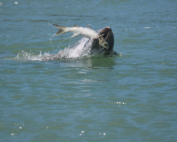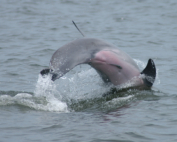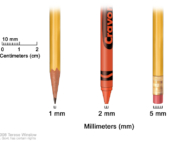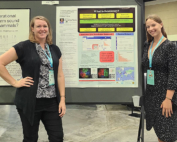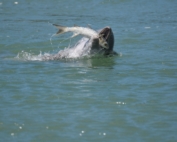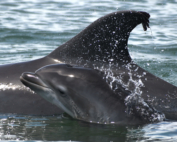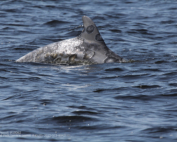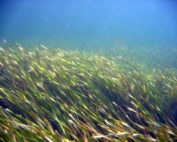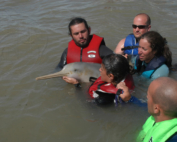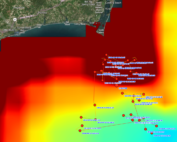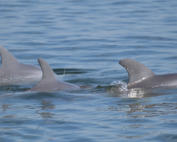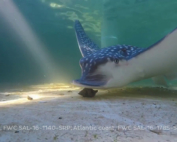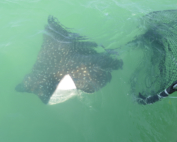Dolphin Ecology
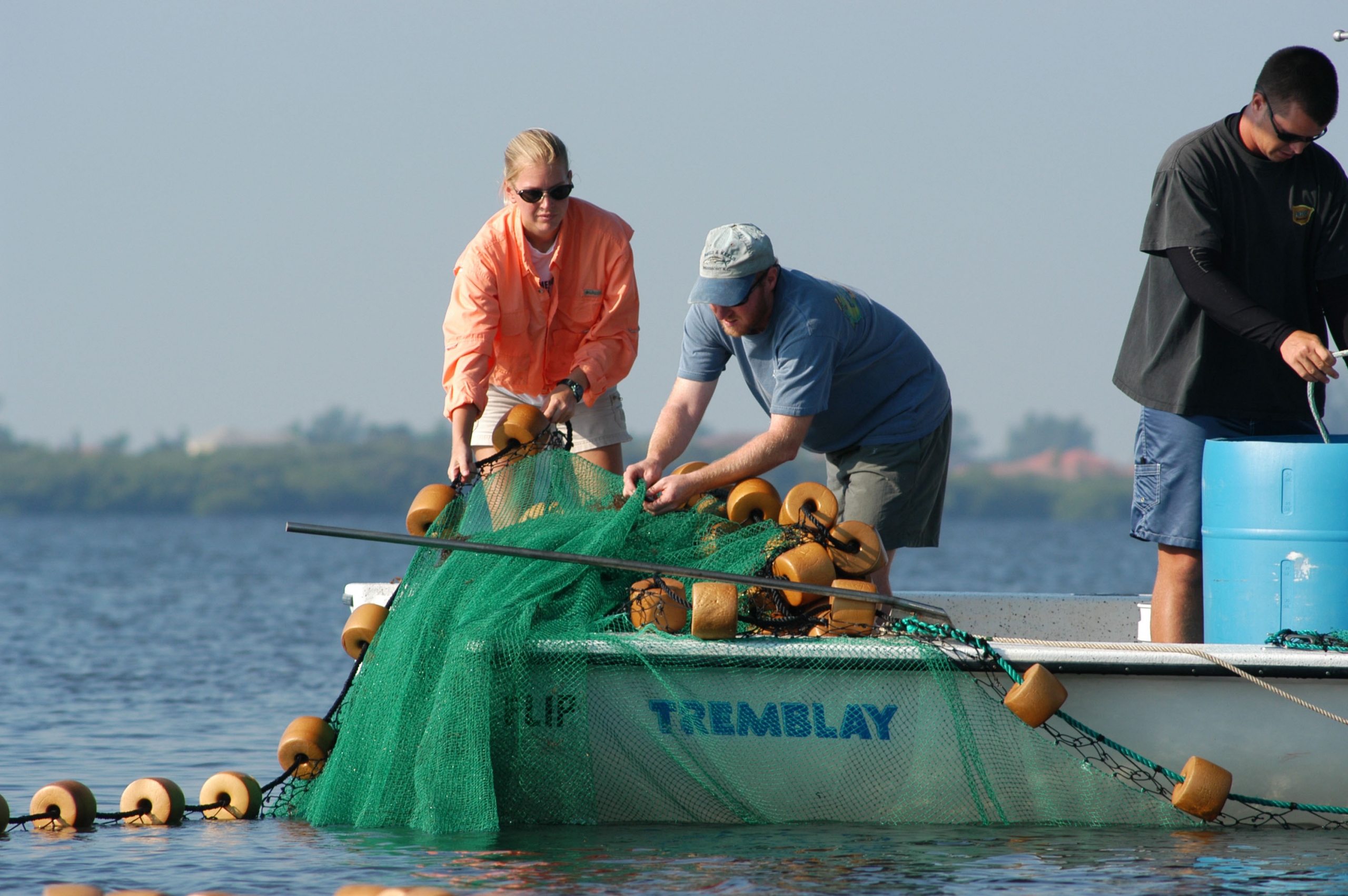
SDRP conducts the world’s longest-running study of a wild dolphin population, initiated in 1970. Information available from five decades of research on the multi-decadal, multi-generational, year-round resident community of individually identifiable bottlenose dolphins of Sarasota Bay established this as a unique natural laboratory for learning about the biology, behavior, ecology, social structure, health, and communication of dolphins, as well as the effects of human activities on them.
Long-term study is crucial for understanding the lives of members of long-lived species such as bottlenose dolphins, and for being able to detect trends in populations relative to changes in their environment. Knowing the long-term geographic range of a population unit allows the measurement of exposure to threats, which in turn facilitates mitigation, including direct interventions.
The ability to observe identifiable individual dolphins of known sex, age, and familial relationships through all of their life history milestones and associated transitions in behavioral and social patterns, to collect data on health and condition, and to then document their reproductive success and cause of death is rare in cetacean research.
Gaining a fuller understanding of dolphins also means studying how they interact with their environment, including other species in their environment (even humans).
Data are collected through a variety of techniques, including systematic photographic identification surveys, periodic catch-and-release health assessments, focal animal behavioral observations, tagging and tracking of dolphins and sharks, remote biopsy dart sampling, fish surveys, and passive acoustic monitoring of fish and dolphin sounds from shore-based listening stations.
As with most animals, there are two main ecological drivers for dolphin behavior: prey and predators.
Long-term catch-and-release purse-seining fish surveys provide information on the seasonal relative abundance of dolphin prey fish in Sarasota Bay.
Potential shark predators on dolphins are tagged and tracked through the Sarasota Coastal Acoustic Network (SCAN) array of acoustic tag tracking stations. A network of passive acoustic listening stations (PALS), facilitated by citizen scientists, provides measures of bioacoustics activity from fish, dolphins, and invertebrates, and measures of human activity from recordings of vessel sounds.
Research is conducted under a series of Scientific Research Permits issued by NOAA’s National Marine Fisheries Service, Special Activity Licenses from the State of Florida, and annual renewals of Institutional Animal Care and Use Committee approvals by Mote Marine Laboratory.
What’s on the Menu?
Since 1970, we’ve been studying Sarasota Bay’s dolphin community — getting to know their lineages, their companions and even their favorite hangouts. But understanding the dynamics of a population of animals also includes understanding
Feeling the Heat
Feeling the Heat During a Hot Summer People around the world are feeling extreme heat this summer and we’re receiving a lot of questions about what the heat might mean for dolphins. In
Dolphins and Microplastics
Study Finds Evidence that Dolphins are Ingesting Microplastics A new study in the peer-reviewed journal Frontiers in Marine Science has found evidence that members of the Sarasota Bay dolphin community are inadvertently ingesting
Understanding Animal Residency
What is animal residency and how do we define and measure it? In marine mammal research, residency is often used to describe the place that animals (or groups of animals) occupy in a given
Fatty Acid Signatures
If they are what they eat, what are dolphins eating? Thanks to our long-term studies — including seasonal fish surveys — we know what the most common prey fish are in Sarasota Bay dolphin
2021 Baby Boom
The Chicago Zoological Society’s Sarasota Dolphin Research Program has documented 22 dolphin births in 2021 to the long-term resident bottlenose dolphin community of Sarasota Bay, Florida, exceeding the record of 21 set in 2017. The
When the Prey is Gone
When the Prey is Gone Gaining a fuller understanding of dolphins also means studying how they interact with their environment, including learning about one of the main ecological drivers for their behavior: prey
When Dolphins and Freshwater Mix
What Happens When Dolphins and Freshwater Mix? Prolonged exposure to freshwater is linked to adverse health conditions, immune deficiencies, and even dolphin deaths, but there’s still a lot we don’t
Seagrass Matters
Seagrass Matters This summer (2021), we've continued our purse-seine catch-and-release fish surveys in Sarasota Bay. These surveys, conducted seasonally since 2004, allow us to gain an indication of the relative
Taking Lessons From Sarasota Abroad
This 2008 photo shows researchers preparing to release a tagged franciscana dolphin in Argentina. Dolphins were held for a brief period while satellite-linked tags were applied and then the dolphins were released on site.
Dolphins & Hurricane Season
Dolphins & Hurricanes One question we’re frequently asked is what dolphins do during hurricanes. The short answer is that we just don’t know. Since it’s not safe for humans on
What is happening to the dolphins near Piney Point?
What is Happening to the Dolphins Near Piney Point? We're monitoring the dolphin community near Port Manatee for impacts from the Piney Point discharges of polluted water If you’ve
Crunch! Understanding Eagle Ray Diets
Crunch! Understanding Eagle Ray Diets For the first time, a team of researchers has demonstrated that passive acoustic recorders can be used to help identify the prey that whitespotted eagle
Uncovering Spotted Eagle Ray Migrations Along Florida’s Coastlines
Uncovering Spotted Eagle Ray Migrations Along Florida’s Coastlines A new study is providing insights into the mysterious migrations of whitespotted eagle rays — uncovering interesting differences in the movements of




